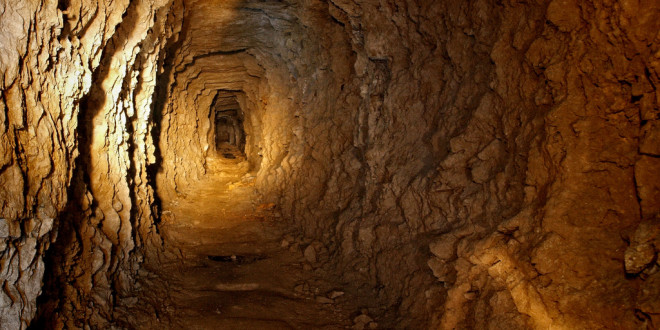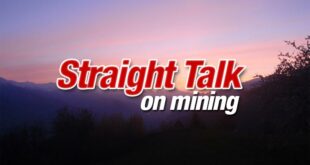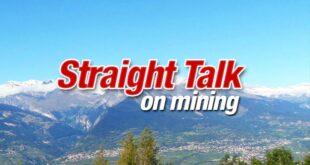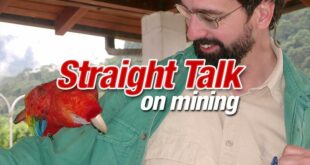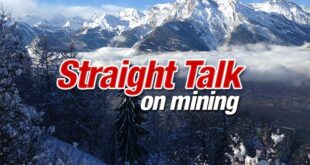I have had a great deal of feedback from my “Silver” essays. Please keep it coming!
Other snippets to report: I mentioned that by-product silver production from some porphyry copper mines is huge, not because they contain high grade silver, but because they mine huge volumes of low grade rock each year. BHP-Billiton announced a few weeks ago that they are cutting back production by 10% at their Escondida open pit, the world’s largest copper mine. Year 2000 production from this mine was 3.28 million ounces (102 tonnes) of by-product silver. Copper porphyry production is being cut back worldwide.
Silver is currently in backwardation. This is a term used when short term lease rates exceed long term – an unusual condition which is typical of a tight supply situation. As of Friday, 14th December, the rates listed on http://www.kitco.com are a whopping 10.91% for 1 month, and 5.41% for one year. With the benchmark US Federal funds rate dropped to 1.75%, it is now very expensive to borrow silver. http://www.silver-investor.com also reports a spread in silver prices between the London and New York markets which is fertile ground for arbitrage and also a sign of market imbalance.
Silver and gold rose significantly on Friday. Maybe silver is in fact dragging gold up with it, or possibly gold’s move is due to a precipitous drop in the value of the South African Rand. The rand fell Friday by 5.7% against the US dollar, and 7.24% against the British pound. It is difficult to explain the rapid demise of the rand, but it may be due to comments made by politicians in support of Robert Mugabe in Zimbabwe. Could the drop in the rand be portending political trouble for South Africa, the world’s largest gold producer? According to a Friday article in the Financial Times, “The weakness of South Africa’s foreign exchange reserve position – in fact the central bank has negative dollar reserves due to failed attempts to support the rand in the derivatives market – makes it hard for the authorities to defend the currency.” What will halt the slide?? Is South Africa headed for financial meltdown a la Argentina?
Gold stocks in North America have done tolerably well this year; but in South Africa their performance has been phenomenal! In a Business Report article dated December 10th, gold guru Nick Goodwin said rand cash earnings of AngloGold would be up by 65 percent, Gold Fields would be 222 percent higher and Harmony could expect its rand cash earnings to rise by 210 percent this quarter. This is because S.A. mining companies are paid for their product in US dollars. In US dollar terms the costs of producing an ounce of gold continues to drop, as the rand drops. It is the huge profits made from a dropping rand that enables AngloGold etc. to go shopping for other miners. Just look what happened on Friday on the Johannesburg Stock Exchange (JSE):
| Closing price | percentage gain Friday, Dec 14th | Year ago | ||
|---|---|---|---|---|
| AngloGold | 45400 c | 11.82% | 21000 c | |
| Durban Roodepoort Deep | 1420 c | 7.98% | 590 c | |
| Gold Fields | 5970 c | 5.66% | 2530 c | |
| Harmony Gold Mining | 8600 c | 10.26% | 3290 c | |
(Please note, these stocks, though quoted on other international exchanges only made the really big moves on the JSE. For instance, AngloGold moved upwards only 3.54% on the NYSE Friday Dec. 14th). Even though the Rand is plunging, note that the percentage gains for these stocks on the day outweighed their drop in value in both dollar and pound terms. South African nationals are limited in the amount of foreign exchange they can purchase, so to buy S.A. gold stocks is not just an investment in gold, but a proxy investment in the US. buck. What is clearly happening is a flight to gold stocks to preserve wealth. If the rand continues to slide, these stocks may be bid up even higher. I would surmise that Kruggerrand sales last week in S.A. were healthy as well.
As a footnote, Egypt devalued their currency Thursday by 7.8% against the dollar. Maybe this is only the tip of the iceberg.
The battle for Normandy Mining wages on. The prize represents much more than just the gold reserves. Unlike zinc or aluminum production, worldwide gold production is not consolidated into a handful of players. It has been an oft-quoted complaint that the gold industry pie is sliced too many ways. Top gold companies are less favoured by some fund managers for this reason. Paul Lassonde, President and Co-Chief Executive of Franco-Nevada has been a champion of industry consolidation, and was quoted as saying back in April, 2001 that consolidation among some of the world’s smaller gold companies will only occur once these firms stop trying to outlast one another by waiting for “the perfect deal”. In a http://www.lemetropolecafe.com article back in August, 2000 entitled “Major Gold Producers Eating their Young” I wrote, “With more or less the entire junior gold exploration sector now moribund, or moved into diamonds and platinum-palladium, the major gold producers have only one avenue to acquire gold mining reserves – turn on each other in a wild orgy of cannibalism.” Only the true visionaries or the reckless are exploring for gold right now, and grassroots probably won’t be kick started again until we see gold past $350/oz. Put all the talk of “synergies” aside – manufacturers can move an office or a plant, but miners can’t move an orebody to where it might suit. The reasons for consolidation come down to the fact that a mine is a wasting asset, and with few new discoveries being made by juniors, the only way to secure gold ounces in the ground is to consolidate. In light of this, it is interesting to pass comment on an advertisement in the Northern Miner newspaper, that has been running now for over a month. Newmont’s ad, entitled: “A New Exploration Model” is an offer to provide select groups of junior and mid-size exploration companies with access to their “$US 1 billion prospect data base”, presumably with a number of strings attached. Newmont has spent about 40 years generating this database and have always held it close to the chest. The about turn signifies that Newmont is throwing in the towel on exploration, and like many other companies intends to buy its new reserves rather than find them.
Epithermal Deposits
These are an extremely important class of deposit. They are typically mixed – gold and silver, though more-or-less gold only or silver only deposits do occur.
“Epi” means “above” and “thermal” means “heat”. These are deposits which form in the shallow environment – at surface or near the surface, by “heated, ascending waters” – think geysers and hotsprings – and their formation closely follows volcanic eruption. Epithermal deposits only form in the feldspar-rich “felsic” and silica-rich “silicic” types of volcanic rock. You won’t find them in basalt, such as that which forms most of the Hawaiian or Galapagos islands.
The heat engine which drives water circulation in volcanic hot spring systems is molten lava rock or “magma” as we call it, that just didn’t quite make it to the surface to flow. It’s down there somewhere, maybe 1 or 2 kilometres down, just sitting and slowly cooling. In some cases the gold and silver come from vapour, and salt and sulphur-rich water, coming off the buried magma. In other cases, the buried magma sets up an underground convection cell, and rainwater which seeps into the ground is heated at depth and then driven back up to the surface. The recirculating water leaches away minute amounts of gold and silver from the rocks and redeposits them elsewhere in veins. Most deposits seemed to have formed through a combination of contributions from recirculating rainwater and from the cooling magma body.
Though it had been widely theorized how epithermal deposits formed, it wasn’t until the 1980’s that the actual mechanism was revealed working in action. At a site called Wairakei, in the North Island of New Zealand, heat from natural hotsprings is used to drive turbines and produce electricity. Soon after the generating plant was commissioned it was found that the pipes placed in the ground to capture the hot water were rapidly clogging up with scale, like the type you find in hard water areas – though in this case the scale contained up to 5% gold! The gold was dissolved with other metals in the water, and when it cooled it was deposited on the wall of the pipe. Since then, many companies have profited in their precious metals search by investigating active hotspring occurrences in volcanic areas. The very rich Ladolam deposit on Lihir Island in Papua New Guinea was found by a geologist who simply visited the island because there were hot springs marked on his topographic map. He found significant gold on surface, the very first day of his expedition.
Because epithermal deposits form at shallow levels, there is no point in looking for them where erosion may have removed 4 or 5 kilometres of rock, because they will have long been worn away by the elements. They are best looked for in areas that are volcanically inactive or long dormant, that have had enough erosion to remove most of the ash and lava beds and expose the “plumbing” of the hotspring systems, where most of the metals can be found. Geologists call such systems “unroofed”. Quite often erosion will expose the “porphyry” rock body that formerly was the molten magma heat engine driving the system. “Porphyry” is just a term used for rocks with lots of visible feldspar and other crystals in it. When molten rocks cool slowly, large crystals tend to form – hence the term “porphyry”. Porphyries can take as long as several million years to cool down after a volcanic eruption has ceased, and for that duration hot springs will be flowing.
Epithermal deposits have a variety of shapes. Typically the hot water will flow along fractures or fault zones, which, when filled in by quartz and ore minerals, forms veins. If the hot water isn’t confined to a fracture zone, say in a porous layer of buried volcanic ash or breccia, very large orebodies can form, and rather than quartz veins there may be a large zone of semi-massive silica containing gold and silver. These types of deposits can be highly lucrative because they lend themselves to mining by cheap bulk-mineable open pit methods.
The Veladero, La Pierina, and Yanacocha deposits are all of epithermal type. Epithermal deposits as stated above are by nature shallow, and at their upper levels are typically mined by open pit. It is often economic to follow vein systems underground by shaft or decline. In the upper levels, the deposits are usually in rocks that are porous and easily crushed, often because they have had hard components altered to soft clays, by hot water and volcanic steam. In addition, the deposits are often weathered at surface as well by a combination of tropical heat and high humidity. Many of the coastal volcanic belts of the world receive heavy rainfall. The air tends to lose its moisture over mountain ranges when it is pushed to higher elevations. This is the reason why many mountain peaks are almost permanently shrouded in mist. High rainfall together with iron pyrite, which is common in epithermal systems, combine together to form natural sulphuric acid. The acid leaches away the soft components of the rock, leaving the gold behind within a friable and easily crushed silica-rich rock. Stuff like this is perfect for heap leach recovery.
Shallow, with moderate to high grades, amenable to cheap mining methods, and cheap metal recovery methods, these deposits win hands down for low cost mining.
Where epithermals geographically occur is constrained by where the volcanic belts with the right type of chemistry are found. The most well-known are in the Circum-Pacific region; an area sometimes called the “Ring of Fire”. The reason for this is that these are areas where oceanic crustal plates are bumping into the continents. In a process called “subduction” the oceanic plates are being overridden, and when they are forced downwards they heat up and melt some distance inboard from the coast. Volcanoes sprout up over the parts of the oceanic plates that is melting way down deep. The volcanic rocks generated are usually silica and feldspar rich. Volcanic chains tend to parallel the coastal edge. Prospective areas for epithermals extend from British Colombia down through California and Nevada, Mexico and Central America. The belt extends the entire length of the South American continent including Chile, Peru, Bolivia, and Argentina. It then hopscotches across the Pacific Ocean, up through the north island of New Zealand, through Papua New Guinea, Indonesia and the Philippines, then to Japan, Sakhalin Island, through Vladivostok and along the Russian coast, then a skip across the Bering Sea to the Katmai Peninsula of Alaska. In some of these very volcanically active areas like Alaska and parts of the Andes, no doubt the deposits are currently forming, but very thick layers of volcanic ash from recent activity hide the underlying geology. These will be prospective areas once Mother Nature has stripped the overburden from them, which might take several million years. Epithermals also occur in extinct volcanic belts, like northern Queensland in Australia; Kazahkstan and Mongolia; Hungary; parts of Spain; and Transylvania in Romania.
The recent gold boom in the South American Andes only began when countries started to relax their foreign investment laws and reform their labour laws. The west coast of South America has proven to be an important frontier region for exploration. The area is by no means exhausted and we can expect a steady stream of new discoveries for many years to come. As low cost operations, existing mines in the region are already among the most lucrative; they will surely become even more so when metal prices rebound.
*****
Straight Talk on Mining is provided for information purposes only. Nothing herein is to be construed as a recommendation to buy or to sell any particular security or financial instrument. Nothing herein is to be construed as a recommendation to engage in any particular investment strategy or trading strategy.
The investments discussed herein may be unsuitable for investors depending on their specific investment objectives, financial situation, and risk tolerance. Private investors should obtain the advice of a qualified financial advisor before entering into any transaction.
Straight Talk on Mining is based on information that is generally available to the public. The sources used are believed to be reliable, but because the information and data that they provide are beyond our control, no representation is made that it is complete or accurate. Staff of Straight Talk on Mining may or may not be invested in the equities mentioned.
References to other publications and direct links to external Internet sites are sometimes given. The inclusion of any publication, organization or Internet site herein does not imply any endorsement. Straight Talk on Mining has no control over the content of any Internet site that you may reach through links that are provided, nor can their truth, accuracy, or completeness be vouched for.
Straight Talk on Mining is not a financial services company nor is it affiliated with any financial service company in any jurisdiction.
The author/publisher, Dr. Keith M. Barron, is not a qualified financial advisor and is not acting as such in this publication. The accuracy of any legal term or definitions used herein should be verified with your legal advisor or the appropriate government agency
 Straight Talk On Mining Insights on mining from economic geologist Dr. Keith Barron.
Straight Talk On Mining Insights on mining from economic geologist Dr. Keith Barron.
